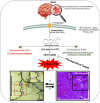This is a preprint.
12/15-Lipooxygenase Inhibition Reduces Microvessel Constriction and Microthrombi after Subarachnoid Hemorrhage in Mice
- PMID: 38947083
- PMCID: PMC11213206
- DOI: 10.21203/rs.3.rs-4468292/v1
12/15-Lipooxygenase Inhibition Reduces Microvessel Constriction and Microthrombi after Subarachnoid Hemorrhage in Mice
Update in
-
12/15-Lipooxygenase Inhibition Reduces Microvessel Constriction and Microthrombi After Subarachnoid Hemorrhage in Mice.Transl Stroke Res. 2025 Aug;16(4):1156-1172. doi: 10.1007/s12975-024-01295-0. Epub 2024 Sep 19. Transl Stroke Res. 2025. PMID: 39294532 Free PMC article.
Abstract
Background and purpose: Impaired cerebral circulation, induced by blood vessel constrictions and microthrombi, leads to delayed cerebral ischemia after subarachnoid hemorrhage (SAH). 12/15-Lipooxygenase (12/15-LOX) overexpression has been implicated in worsening early brain injury outcomes following SAH. However, it is unknown if 12/15-LOX is important in delayed pathophysiological events after SAH. Since 12/15-LOX produces metabolites that induce inflammation and vasoconstriction, we hypothesized that 12/15-LOX leads to microvessel constriction and microthrombi formation after SAH, and thus 12/15-LOX is an important target to prevent delayed cerebral ischemia.
Methods: SAH was induced in C57BL/6 and 12/15-LOX-/- mice of both sexes by endovascular perforation. Expression of 12/15-LOX was assessed in brain tissue slices and in vitro. C57BL/6 mice were administered either ML351 (12/15-LOX inhibitor) or vehicle. Mice were evaluated for daily neuroscore and euthanized on day five to assess cerebral 12/15-LOX expression, vessel constrictions, platelet activation, microthrombi, neurodegeneration, infarction, cortical perfusion, and for development of delayed deficits. Finally, the effect of 12/15-LOX inhibition on platelet activation was assessed in SAH patient samples using a platelet spreading assay.
Results: In SAH mice, 12/15-LOX was upregulated in brain vascular cells and there was an increase in 12-S-HETE. Inhibition of 12/15-LOX improved brain perfusion on days 4-5 and attenuated delayed pathophysiological events, including microvessel constrictions, microthrombi, neuronal degeneration, and infarction. Additionally, 12/15-LOX inhibition reduced platelet activation in human and mouse blood samples.
Conclusions: Cerebrovascular 12/15-LOX overexpression plays a major role in brain dysfunction after SAH by triggering microvessel constrictions and microthrombi formation, which reduces brain perfusion. Inhibiting 12/15-LOX may be a therapeutic target to improve outcomes after SAH.
Keywords: 12/15-Lipooxygenase; arterioles; delayed neurological deficit; microthrombi; microvessel constrictions; platelets; subarachnoid hemorrhage.
Conflict of interest statement
Potential conflict of interests The authors declare no competing interests.
Figures












References
Publication types
Grants and funding
LinkOut - more resources
Full Text Sources

